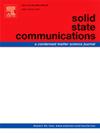用于自旋电子应用的 ZnCrO3 包晶石的新型半金属铁磁性、机械稳定性、光电和热电特性的 DFT 理论预测
IF 2.1
4区 物理与天体物理
Q3 PHYSICS, CONDENSED MATTER
引用次数: 0
摘要
基于密度泛函理论(DFT)的计算描述了 ZnCrO3 包晶的结构稳定性、光电、机械以及热电特性。为了确定交换关联势,使用了著名的广义梯度近似(GGA)和 mBJ 势积分。透辉石显示出这是一种具有 Fm3m 对称性的立方结构。此外,为了检验稳定性,还对内聚能、结构优化和机械稳定性提出了要求。结果发现,这种包晶是脆性的,其机械稳定性通过弹性常数得到增强。从自旋极化电子带轮廓、介电常数的行为以及自旋上升和下降通道中的吸收系数可以看出,这种过氧化物具有半金属特性。在这篇文章中,我们还研究了磁性和半金属间隙的起源。在晶体场中,M 位元素的分裂 d 轨道中的未成对电子是半金属和磁性特征的原因。费米级的出色自旋极化促进了包晶在自旋电子技术中的应用。最后,我们计算了不同温度(300 K、600 K、900 K)下化学势内的热电参数,以探索自旋电子器件的潜在应用。我们的研究结果表明,ZnCrO3 合金在室温和高温条件下用于下一代自旋电子学和热电器件是非常有前途的。本文章由计算机程序翻译,如有差异,请以英文原文为准。
A DFT theoretical prediction of new half-metallic ferromagnetism, mechanical stability, optoelectronic and thermoelectric properties of ZnCrO3 perovskites for spintronic applications
ZnCrO3 perovskites structural stability, optoelectronic, mechanical, along with thermoelectric properties, have all been to be described by calculations based on density functional theory (DFT). To determine the exchange correlation potential, the well-known generalized gradient approximation (GGA) and integration of the mBJ potential were used. The perovskite shows that this is in a cubic structure with Fm3m symmetry. Additionally, to check the stability, cohesive energy, structural optimization, and mechanical stability were requirements. This perovskite was found to be brittle, and their mechanical stability enhanced by the elastic constants. The perovskite has a half-metallic character, as evidenced by the spin-polarized electronic band profile, the behavior of the dielectric constant, and absorption coefficient in the spin-up and down channels. In this article, we also looked at magnetism and the origin of the half-metallic gap. The unpaired electrons in the split d-orbitals of the M-sited elements in the crystal field are responsible for the half-metallic as well as magnetic characteristics. Excellent spin polarization at the Fermi level encourages perovskite's possible use in spintronic technologies. Lastly, we computed the thermoelectric parameters within a chemical potential at various temperatures (300 K, 600, 900 K) to explore the potential application in spin electronic devices. Our finding shows that the ZnCrO3 alloy is exceptionally promising for the next generation of spintronics and thermoelectric devices at room and high temperatures.
求助全文
通过发布文献求助,成功后即可免费获取论文全文。
去求助
来源期刊

Solid State Communications
物理-物理:凝聚态物理
CiteScore
3.40
自引率
4.80%
发文量
287
审稿时长
51 days
期刊介绍:
Solid State Communications is an international medium for the publication of short communications and original research articles on significant developments in condensed matter science, giving scientists immediate access to important, recently completed work. The journal publishes original experimental and theoretical research on the physical and chemical properties of solids and other condensed systems and also on their preparation. The submission of manuscripts reporting research on the basic physics of materials science and devices, as well as of state-of-the-art microstructures and nanostructures, is encouraged.
A coherent quantitative treatment emphasizing new physics is expected rather than a simple accumulation of experimental data. Consistent with these aims, the short communications should be kept concise and short, usually not longer than six printed pages. The number of figures and tables should also be kept to a minimum. Solid State Communications now also welcomes original research articles without length restrictions.
The Fast-Track section of Solid State Communications is the venue for very rapid publication of short communications on significant developments in condensed matter science. The goal is to offer the broad condensed matter community quick and immediate access to publish recently completed papers in research areas that are rapidly evolving and in which there are developments with great potential impact.
 求助内容:
求助内容: 应助结果提醒方式:
应助结果提醒方式:


